Welcome to Product. In this topic, you will learn about:
- Product definition
- Levels of product
- Product attributes
- Branding
- Packaging
- Labelling and logos
- Product support services
- Product lines
- Product life cycle
The marketing mix consists of the tools used by the organisation to create a desired response among its target market and is commonly referred to as the “4 P’s”.

Each of the four P’s represents product, price, promotion and place, these are elements we must focus on to successfully market a product. Within this topic, we will focus on product.
Product includes all aspects of the product design, it's packaging, and any associated aspects (such as warranty and free delivery). Determining the specific combination of benefits sought by consumers is a key marketing task.
Products and services
A product is anything that can be offered to a market for attention, acquisition, use or consumption that might satisfy a want or need. Broadly defined, products include services, events, persons, places, organisations, and ideas, or a mixture of these.
Services are a form of product that consists of activities, benefits, or satisfactions offered for sale that are essentially intangible and do not result in the ownership of anything.
Market offerings include both tangible goods and services. With this in mind, companies create and manage customer experiences with their brands or companies and aim to differentiate their offers from that of the competitors
Purchasing experience
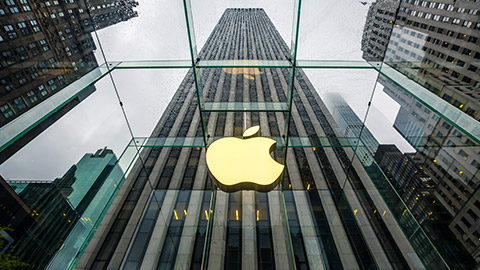
The atmosphere or physical environment can be the customer's reason for choosing, or not choosing, to do business with an establishment. It can be multidimensional such as visual, aural, olfactory and tactile, allowing customers to experience the product in various ways.
Let us consider Apple’s retail stores, they are very seductive places, this is no mistake. Take their store design for exaple, it is clean, simple, and just oozing with style, much like their products a physical environment which encourages purchasing, but also lingering, with tables full of fully functioning Macs, iPads, and iPhones sitting out for visitors to try their product freely, along with tutorials to ensure you get the most out of your product.
Three levels of product
To explore the fundamentals of a product in detail, let us first consider each level as three separate products, such as:
- Core customer value
- Value the actual product
- The augmented product.
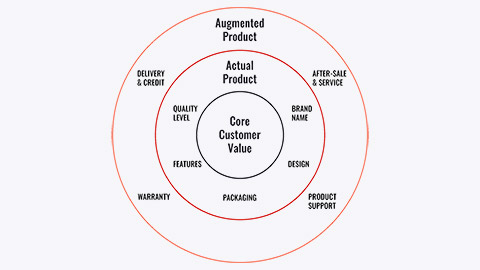
At the most basic level, the company asks “what is the customer really buying?” For example, people who buy an Apple iPad are buying more than just a tablet computer. They are buying entertainment, self-expression, productivity and connectivity– a mobile and personal window to the world.
Core customer value
The core customer value deals with what is bought by the customer. For example, people who buy an Apple iPad are buying much more than just a tablet computer, they are buying entertainment, self-expression, productivity, and connectivity with friends and family—a mobile and personal window to the world. The core product is what the buyer is really buying, selling the benefits rather than the features. For instance, A 4-night holiday in Dublin is not simply the purchase of an air ticket, hotel, sightseeing, and meals,its’ benefits include cultural enrichment, a return to one’s roots, romance, etc. Another example, when purchasing a skincare product, you do not buy the fragrant cream in the fancy jar, instead, the core product is really how it improves the skin, such as an anti-aging benefit.
Actual product
At the second level, product planners must turn the core benefit into an actual product. They need to develop product and service features including, a design, a quality level, a brand name, and packaging. For example, the iPad is an actual product, from its name, parts, styling, operating system, features to its packaging and other attributes, these have all been carefully combined to deliver the core customer value of staying connected.
Augmented product
Finally, product planners must build an augmented product around the core benefit and actual product by offering additional consumer services and benefits. The augmented product includes accessibility, customer participation, atmosphere and customers’ interaction with the service organisation and each other, a combination of what is offered with how it is delivered. For example, when consumers buy an iPad, Apple and its resellers also might give buyers a warranty on parts and workmanship, quick repair services when needed, and a web site to use if they have problems or questions, going one step further, Apple also provides access to a huge assortment of apps and accessories.
Individual product decisions

This image shows the important decisions in the development and marketing of individual products and services. Let us review each of these aspects and their contribution to the creation of core customer value.
Developing a product or service involves defining the benefits that it will offer. Product quality refers to the characteristics of a product or service that bear on its ability to satisfy stated or implied customer needs, this is one of the marketer’s major positioning tools. Total quality management (TQM) is an approach in which all of the company’s people are involved in constantly improving the quality of products, services, and business processes. As products can be offered with varying features,another way to add customer value is through distinctive product style and design.
See the following examples and recognition of the product and attributes.
Rolex
Manufacturing company - watches
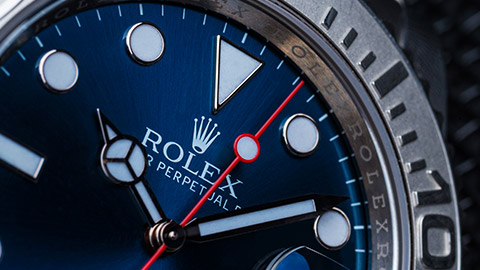
Switzerland secured second place in the overall ranking of its products, evoking consumer sentiments of authenticity and status.
Mercedes-Benz
Luxury vehicles company

Germany tops a list of the nations on earth most respected for the quality of their products and goods.
A brand is a name, term, sign, symbol, or design or, indeed, a combination of these that identifies the maker or seller of a product or service. Consumers view a brand as an important part of a product, and branding can add value to a consumer’s purchase. Brand names help consumers identify products that might benefit them, as well as saying something about product quality and consistency. The following illustration provides examples of brand name advantages.
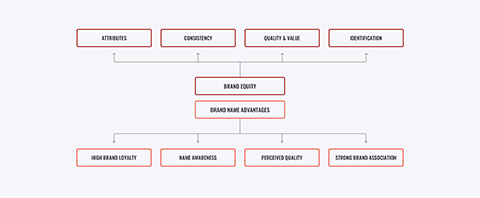
Conditions which support branding
The development of a brand name is key in developing the identity of the brand, with three main conditions which should be considered in order to achieve a desired brand name. These are:
1. The product is easy to identify by brand or trademark.
Desirable characteristics of a brand name should:
- suggest something about the product’s benefits and qualities
- be easy to pronounce, recognise & remember
- be distinctive
- look into foreign markets it should translate easily into foreign language
- be capable of registration legal protection.
2. The product is perceived as the best value for the price.
A brand name derives its value from consumer perceptions, expectations and the brands’ strong reputations. For example:
- Paris
- Tiffany
- Toyota
- Tesla
Each of these have built strong reputations with quality products and service that can at times, come with a high price tag, however, consumers’ are likely to spend more on a product they trust than less on one they do not know much about.
3. Quality & standards are easy to maintain.
It is important to have consistent branding with all your products as it ill help in re-enforce the brands key-message and unique attributes that stand out from the rest. Slight changes can be of benefit, but extreme changes to branding such as the name, logo, products etc. can tarnish the branding the company has worked hard to create.
Leveraging brand equity
Brand equity can be leveraged by cobranding & partnerships for example, YUM! Brands, Inc. Is a fast-food company that operates various restaurant brands, including KFC, Pizza Hut, Taco Bell, The Habit Burger Grill. Today it operates 50,000 restaurants in more than 150 countries and usually position themselves next to each other, or under one roof!
Products with strong brand equity provide brand extension opportunities for marketers meaning new products can be introduced and sold under the same brand name. The new product will attract customers immediately, just because of the name, and the marketers may be able to price it higher than if introducing an entirely new brand that consumers are unfamiliar with.
Here is a fun fact, Touchstone films, productions which are targeted at older audiences was created when Disney decided to expand their movies beyond those targeting young children. Disney realized the importance of creating a sub-brand that could be marketed separately from existing Disney films, and this is when Touchstone film brand was born. These productions typically often feature more adult content in terms of language and mature scenes that are not appropriate for young children, targeting a new market, under a new name through an existing brand
Of course, if brand extensions fail, it can create brand dilution that causes consumers' perceptions of the brand to shift and may have an impact on brand equity and brand loyalty.
Why brands matter
Strong brands forge lasting bonds with customers based on brand meaning, let us look a little deeper.
Brand meaning encompasses the beliefs and associations a consumer has about the brand therefore marketers build brand loyalty based on brand meaning. Today, brand meaning spreads virally as people share their story online with one another. With the increasing popularity of social networking and all forms of digital communication, marketers find this is an effective method to use for storytelling to assist in building on their brand meaning. Through brand storytelling, marketers seek to engage consumers with compelling stories about brands that connect with consumers and establish its identity.
Brand personality is a distinctive image that captures the characteristics and benefits of a good or service. It is the image that a consumer has about a brand and is closely related to brand meaning. One of the best ways to give a brand a personality is to engage in marketing actions that make a brand seem human, attributing human characteristics to a brand-this is known as brand anthropomorphism.
Brands are in many ways like people. Most consumers are, if asked, able to describe what a product would be like if it came to life, including detailed descriptions of colour hair, type of house, and body image.
Characteristics of world class brands
Here are the ten common characteristics of the world’s top brands
- Excels at delivering the benefits customers desire
- Stays relevant
- Its' pricing strategy is based on consumer’s perceptions of value
- Is properly positioned
- Is consistent
- Its' portfolio and hierarchy make sense
- It coordinates a full repertoire of marketing activities to build equity
- Its' managers understand what the brand means to consumers
- It is given proper support
- The company monitors sources of equity.
Branding and packaging
Branding and packaging decisions play an essential role in shaping how consumers view a product. While there are many types of decisions to be made, each should conform with the overall product strategy and needs of target markets. View the three examples of effective branding and packaging shown in the images below.
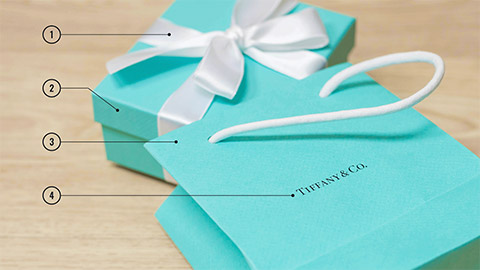
1. The accent
A white satin ribbon, tied on at the counter, is the de rigueur accompaniment to the signature blue box. During the holidays, Tiffany uses a red ribbon instead.
2. The box
Pantone makes the blue-coated paper packaging for Tiffany. The store’s flagship might be on New York’s Fifth Avenue, but the boxes come from Carlstadt, N.J.
3. The colour
Pantone No. 1837 (coined for the year of Tiffany’s founding) is also know as forget-me-not blue and robin’s egg blue. It is the most protected colour in branding.
4. The name
Tiffany & Co boxes are embossed in Baskerville Old Face, with Tiffany & Co. – but they really don’t need to be. The blue pretty much says it all.
Packaging involves designing the container or wrapper for a product. With ever increasing competition in the market, packages must now perform many sales tasks, from attracting buyers to communicating brand positioning to closing the sale. Read the article (located within the additional resources at the end of this topic) which discusses how the popular jewellery company, Tiffany & Co. carefully designed their packaging and became renowned for becoming the worlds most popular package.
Labels help to identify and describe the product or brand as well as promote the brand along with supporting its positioning and engage customers.
Brands
Brands are among a company’s most valuable assets and represent what the company is and what it stands for. A strong brand will imply trust, consistency, and a defined set of expectations and the strongest will own a place in the customer’s mind.
Evolution of Apple and starbucks logos

Brand mark
Part of the brand that can be recognized but is not utterable is to have a unique symbol, design, distinctive colouring or lettering. Have a look at the below brand marks, for example.
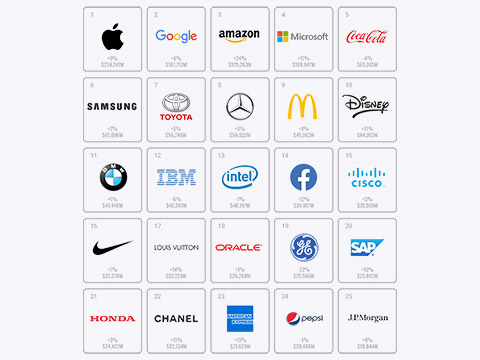
Trademark
A trademark is a brand or part of a brand that is given legal protection. It protects the seller’s exclusive rights to use the brand name or brand mark.
Here is an interesting fact. When Burger King decided to expand its operations into Australia, it found that its business name was already trademarked by a man running a small takeaway food shop in Queensland. As a result, Burger King provided the Australian franchisee, Jack Cowin, with a list of possible alternative names that the Australian Burger King restaurants could be branded as. The names were derived from pre-existing trademarks already registered by Burger King and its then corporate parent Pillsbury. Jack Cowin selected the "Hungry Jack" brand name, one of Pillsbury's US pancake mixture products, and slightly changed the name to a possessive form by adding an apostrophe 's' thus forming the new name Hungry Jack's. Accordingly, the first Australian franchise of the Burger King Corporation, established in Perth in 1971, was branded as Hungry Jack's.
The first step in designing product support services is to survey customers periodically. Once the company has assessed the quality of various support services, it can then take steps to fix problems and add new services that will both delight customers and yield profits to the company.
Service characteristics
Below you will see four special service characteristics a company must consider when designing marketing programs. These are:
- Service intangibility means that services cannot be seen, tasted, felt, heard, or smelled before they are bought. To reduce uncertainty, buyers look for signals of service quality, when doing so they draw conclusions about quality from the place, people, price, equipment, and communications that they can see.
- Service inseparability means that services cannot be separated from their providers, whether the providers are people or machines. Customer coproduction makes provider–customer interaction a special feature of services marketing resulting in both the provider and the customer affect the service outcome.
- Service variability means that the quality of services depends on who provides them as well as when, where, and how they are provided. For example, within a Marriott hotel, one registration-counter employee may be cheerful and efficient, whereas another standing just a few feet away may be grumpy and slow.
- Service perishability means that services cannot be stored for later sale or use. Some doctors charge patients for missed appointments because the service value existed only at that point and disappeared when the patient did not show up.
Marketing tasks for service companies
Service companies face three major marketing tasks: They want to increase their service differentiation, service quality, and service productivity. See below how this can be achieved.
- Managing service differentiation
- Developing a differentiated offer, delivery, and image
- Managing service quality
- Delivering consistently higher quality than the competitors
- Managing service productivity
- Training current employees or hiring new ones
- Increasing the quantity of service by giving up some quality
- Harnessing the power of technology
In these days of intense price competition, service marketers often complain about the difficulty of differentiating their services from those of competitors. The solution to price competition is to develop a differentiated offer, delivery, and image. For example, Dick’s Sporting Goods’ customers can sample shoes on Dick’s indoor footwear track, test golf clubs with an on-site golf swing analyser and putting green, shoot bows in its archery range, and receive personalised fitness product guidance from an in-store team of fitness trainers. A service firm can differentiate itself by delivering consistently higher quality than its competitors provide. Service providers need to identify what target customers expect in regard to service quality, none the less, as hard as they may try, even the best companies will have an occasional late delivery, burned steak, or grumpy employee. However, good service recovery can turn angry customers into loyal ones. With their costs rising rapidly, service firms are under great pressure to increase service productivity, this can be done so in several ways such as, they can train current employees better or hire new ones who will work harder or more skillfully, or they can increase the quantity of their service by giving up some quality. Finally, a service provider can harness the power of technology, however, companies must avoid pushing productivity so hard that doing so reduces quality. For example, many airlines in their attempts to improve productivity, have mangled customer service.
Product or service quality
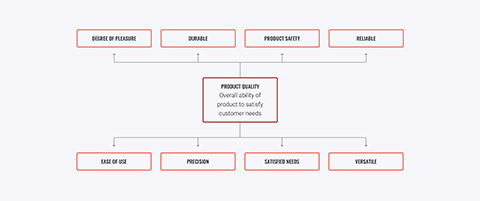
The image above summarises the many meanings of product quality. Different customer expectations, such as durability, versatility, and precision are important for different types of products, though all should satisfy needs. Some customers value reliability, while others value ease of use. Regardless, it is important to recognise that each of these factors contributes to the level and consistency of product quality.
Product line decisions
A product line is a group of products that are closely related because they function in a similar manner, are sold to the same customer groups, marketed through the same types of outlets, or fall within given price ranges, for example, Nike produces several lines of athletic shoes and apparel. The major product line decision involves product line length, which is the number of items in the product line.
A company can expand its product line in two ways:
- line filling
- line stretching.
Line filling involves adding more items within the present range of the line. There are several reasons for product line filling such as reaching for extra profits, satisfying dealers, using excess capacity, being the leading full-line company, and plugging holes to keep out competitors.
Line stretching occurs when a company lengthens its product line beyond its current range. The company can stretch its line downward, upward, or both ways. A reason for downward product line stretching is to plug a market hole that would attract a potential competitor, the reason for the upward product line stretching is to add prestige to the current product. Below are a few examples of how companies have implemented a product line.
Coca Cola
Product line and product mix
| Aerated beverages | Coca Cola, Diet Coke, Thums Up, Sprite, Fanta, Limca, Kinley, Schweppes, Seagram's |
|---|---|
| Energy drinks | Burn, Buzz, Mother (Aus), Real Gold (Jap), Rockstar, Samurai (Vet), Scorpion (Jap) |
| Bottled water | Ades (Ina), Kinley, Bonaqua, Cristal (m), Dasani (b), Ice Dew (chi b), Kiwi Blue, Malvern water (scw) |
| Fruit based beverages | Bibo, Cappy, Five Alive, Mazza, Amita (Ger), Minute Maid, Lift (US), Oasis (UK) |
| Tea/coffee products | Enviga (US), Refreash tea, Far Coast (Can), Saryusaiai (Jap), Georgia Gold Peak Tea (US) |
| Sports drinks | Aquarius, Powerade |
| Vending machines | Georgia |
| Canned soup | Bistrone |
| J.V. & co-brand products | Bacardi mixers, Nestea |
Coca-Cola has product brands like Minute Maid, Sprite, Fanta, Thumbs up, etc. under its name, these constitute the width of the product mix. There area total of 3500 products handled by the Coca-Cola brand, these constitute the length. Minute Maid juice has different variants like apple juice, mixed fruit just to name a few, these constitute the depth of the product line ‘Minute Maid’.
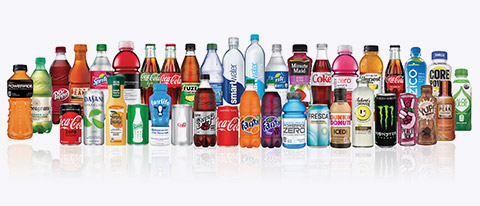
BMW
Through skilful line stretching and filling, BMW now has brands and lines that successfully appeal to the consumers with a variety of income, from average salaries to very high salaries.
Colgate
“Colgate World of Care”—products that “every day, people like you trust to care for themselves and the ones they love.”
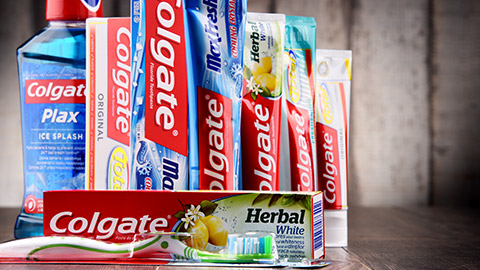
Colgate is a $15.2 billion consumer products company that makes and markets a full product mix consisting of dozens of familiar lines and brands. Colgate divides its overall product mix into four major lines: oral care, personal care, home care, and pet nutrition. Each product line consists of many brands and items.
Product mix decisions
A company’s product mix has four important dimensions that help increase business:
- Width- a company can add new product lines, essentially widening its' product mix.
- Length - lengthening existing product lines can enable a company to become a more full-line company.
- Depth- adding more versions of each product would deepen its' product mix
- Consistency- a company can pursue more or less product line consistency depending on whether it wants to have a strong reputation in a single field or in several fields.
Marketers understand how a product changes over its lifetime. The product life cycle model suggests that products go through four distinct stages from birth to death. These are:
- Introduction
- Growth
- Maturity
- Decline.
Understanding the product life cycle is important because different strategies are appropriate at different stages of the product’s life. Sales and profits vary with each stage as shown in the image below.
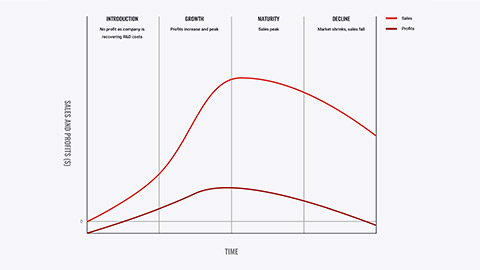
Product life cycle stages
The product life cycle framework is a useful tool to help consider how marketing tactics may need to change over time. However, the product life cycle framework can be quite generalised as some products do not always move evenly through the predicted stages and it can be difficult to know when a product passes from one stage to the next. Some companies are now using social media to bring products “back from the dead.”
Click on each stage to have a closer look into the product life cycle and what occurs during each phase.
This phase is when a product is initially introduced into the market. Slow growth occurs for newly introduced product as the company’s key objective is to get first-time buyers to try a product. Often if a new product offshoots off another well-known brand/s, it can have an advantage to those that are completely new. Both effective advertising and promotion are essential in this birth phase to help promote awareness, but on the same hand, will not usually make a profit during this stage. A great deal of money is spent on marketing communications which create awareness for the product and where it can be found. The initial pricing strategy may set at a high price more quickly to recover R&D expenditures, or a low price to encourage greater sales and market penetration.
It is impossible to know how long any product will spend in the introduction or any other stage of the product life cycle. The amount of money that a manufacturer is willing to invest in the product’s start-up can either shorten or prolong the introduction stage. Unfortunately, many products never make it out of the introduction stage, and lack of a budget for marketing communications is often the problem. As many as 95% of new products ultimately fail, therefore, it is important that this stage has to be well executed.
Product is accepted by the marketplace and sales increase rapidly during the growth stage of the product life cycle, a marketers’ key objective is to encourage brand loyalty by convincing consumers of the brand’s superiority. Furthermore, firms often introduce product variations to attract market segments with different needs and to increase market share. Advertising and sales promotions are especially important to this phase of the life cycle, and price competition may begin to develop between different brands.
Maturity is usually the longest stage of the product life cycle. Here, sales are at their peak, but the high level of market competition often results in competetive pricing and frequent sales promotion, which may narrow profit margins. Often, firms monitor consumer trends and adapt existing products, or bring out new variants in order to keep pace with changing consumer needs- it is important to note that other aspects of the marketing mix may be altered as well.
A steady decrease in sales and profits characterises the decline phase of the product life cycle. Often the root cause of declining sales is a product becoming obselete that has been forced by new technology or a radical change in consumer needs. With the aim of the firm being to remain profitable, marketers must typically decide whether to stay in the game or phase out a product. A phase-out can occur in stages until existing inventory runs out, or the firm can have a fire sale and dump inventory immediately. Firms that decide to keep a product in decline attempt to maximise their profit by minimising costs: very little investment in advertising or other forms of marketing communications are undertaken. The e-commerce marketplace has extended the life of many products that would have otherwise died without advertising support.
Below you will find marketing mix strategies throughout the product life cycle, pay close attention to each stage of the life cycle and how characteristics are affected in each phase.
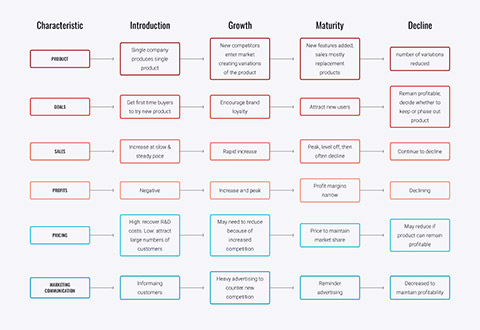
End of topic forums
There are forum activities for this topic. Select the ‘Forum’ at the end of your module (which can be found within your navigation menu) and follow the instructions for each question pertaining to 6 within the forum.
Check out the following website to see which are the top 100 most valuable brands in 2019:
Interbrand- The Top 100 Most Valuable Brands 2019
Read the following articles regarding branding and trademark of popular brands.
How Tiffany’s Iconic Box Became the World’s Most Popular Package
How the ‘I Heart NY’ Logo Transcended Marketing and Endures 4 Decades After Its Debut
The I Love New York Logo Is An Iconic, Widely-Imitated Tourism Symbol
Hungry Jack’s is a famous brand in Australia and the USA
How Hungry Jack's took on Burger King, and won
Further reading
Made In Where? The Countries With The Best Reputations For Producing Quality

